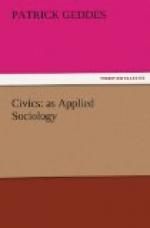A moment of historical reflection suffices to see that the former is the architecture of a long-settled agricultural place, with its spreading undefended villages, in which each household had its separate dwelling, the other a persistence of the Continental fortified city crowded within its walls.
But beyond this we must see the earlier historic, the simpler geographic origins of the French courtyard house as a defensible farmyard, of which the ample space was needed nightly for defence against wild beasts, if not also wilder men, against whom the concierge is not only the antique porter but the primitive sentinel.
I may seem unduly to labour such points, yet do so advisedly, in order to emphasise and make clearer the essential thesis of this portion of my paper—that every scientific survey involves a geographic and historic exploration of origins, but that of the still unwritten chapter, that the far-reaching forelook, idealistic yet also critical, which is needful to any true and enduring contribution to social service, is prepared for by habitually imaging the course of evolution in the past.
Speaking personally, as one whose leisure and practical life have alike been largely spent in the study and the preservation of ancient buildings, I may say that this has not been solely, or even essentially, from an antiquarian interest in the historic past, but still more on behalf of a practical interest—that of the idealistic, yet economic, utilitarian, because educational and evolutionary, transformation of our old cities—old Edinburgh, old Dunfermline, and the like—from their present sordid unhygienic failure; and therefore industrial and commercial insufficiency, towards a future equalling if not transcending the recorded greatness of the civic past.
It has, therefore, been to lay the broadest possible basis of evolutionary science, of geographic and historic fact, for what would otherwise be open to ridicule as a Utopian hope, that of Civics as Applied Social Art, that I have insisted at such length above upon Civics as Applied Social Science.
[Page: 139] PRESS COMMENTS
The Times (July 20, 1904) in a leading article, said:




